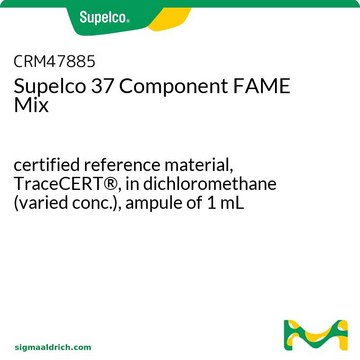62230
Linoleic acid
analytical standard
Synonym(s):
cis-9,cis-12-Octadecadienoic acid
About This Item
Recommended Products
grade
analytical standard
Quality Level
assay
≥98.0% (GC)
shelf life
limited shelf life, expiry date on the label
technique(s)
HPLC: suitable
gas chromatography (GC): suitable
refractive index
n20/D 1.466 (lit.)
n20/D 1.470
bp
229-230 °C/16 mmHg (lit.)
mp
−5 °C (lit.)
density
0.902 g/mL at 25 °C (lit.)
application(s)
cleaning products
cosmetics
flavors and fragrances
food and beverages
personal care
format
neat
functional group
carboxylic acid
storage temp.
2-8°C
SMILES string
OC(CCCCCCC/C=C\C/C=C\CCCCC)=O
InChI
1S/C18H32O2/c1-2-3-4-5-6-7-8-9-10-11-12-13-14-15-16-17-18(19)20/h6-7,9-10H,2-5,8,11-17H2,1H3,(H,19,20)/b7-6-,10-9-
InChI key
OYHQOLUKZRVURQ-HZJYTTRNSA-N
Looking for similar products? Visit Product Comparison Guide
General description
Application
- Multi-residue analysis of oleic acid and other related fatty acids using a derivatization-free method based on gas chromatography-flame ionization detection (GC-FID)
- Separation and quantification of palmitic, oleic, linoleic, and linolenic acids from 186 samples of sea buckthorn seed oil using near-infrared spectroscopy (NIR) in combination with four different combinations of multivariate calibration methods— partial least squares (PLS), PLS-uninformative variables elimination (UVE), PLS- competitive adaptive reweighted sampling (CARS), and multiple linear regression (MLR)-UVE
- Separation and determination of fatty acids by gas chromatography (GC) and amino acids by ultra-fast liquid chromatography-ultraviolet (UFLC-UV) detection from goldband goatfish harvested during different seasons
- Ultra-performance liquid chromatography-mass spectrometry (UHPLC) method-based separation, identification, and determination of eight saturated and unsaturated fatty acids in eight different commercial samples of olive oil without any prior sample treatment
- Magnetic solid-phase extraction of free fatty acids from edible oil samples using monodisperse magnetic single-crystal ferrite (Fe3O4) nanoparticles for their determination by gas chromatography-flame ionization detection (GC-FID)
Biochem/physiol Actions
Other Notes
Storage Class
10 - Combustible liquids
wgk_germany
WGK 1
flash_point_f
>235.4 °F - closed cup
flash_point_c
> 113 °C - closed cup
ppe
Eyeshields, Gloves
Choose from one of the most recent versions:
Already Own This Product?
Find documentation for the products that you have recently purchased in the Document Library.
Articles
The potential for the prevention and treatment of cardiovascular disease through increased dietary intake of omega-3 (w-3) fish oils is not a recent scientific discovery.
Protocols
Separation of Palmitic acid; Linoleic acid; Palmitelaidic acid; Linolelaidic acid; Stearic acid; Oleic acid; Elaidic acid; Methyl palmitoleate.
Our team of scientists has experience in all areas of research including Life Science, Material Science, Chemical Synthesis, Chromatography, Analytical and many others.
Contact Technical Service






